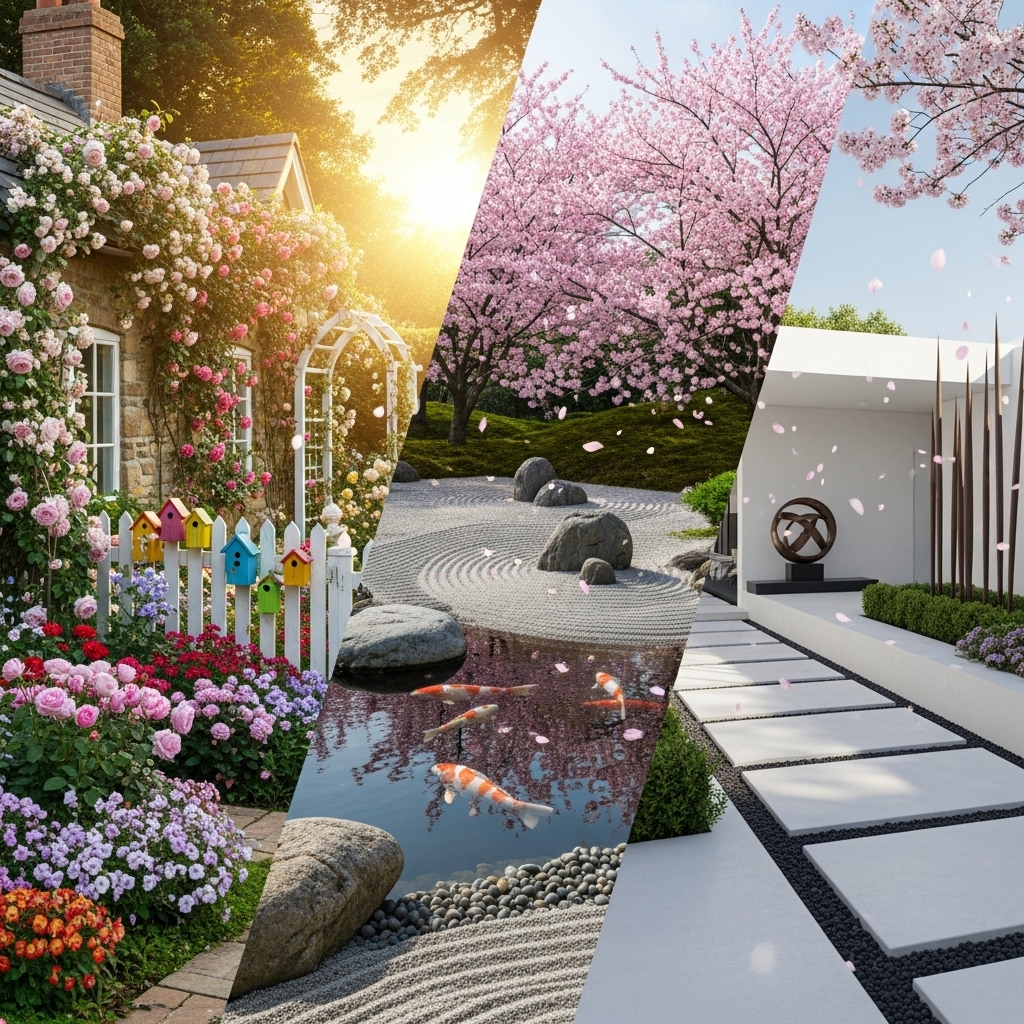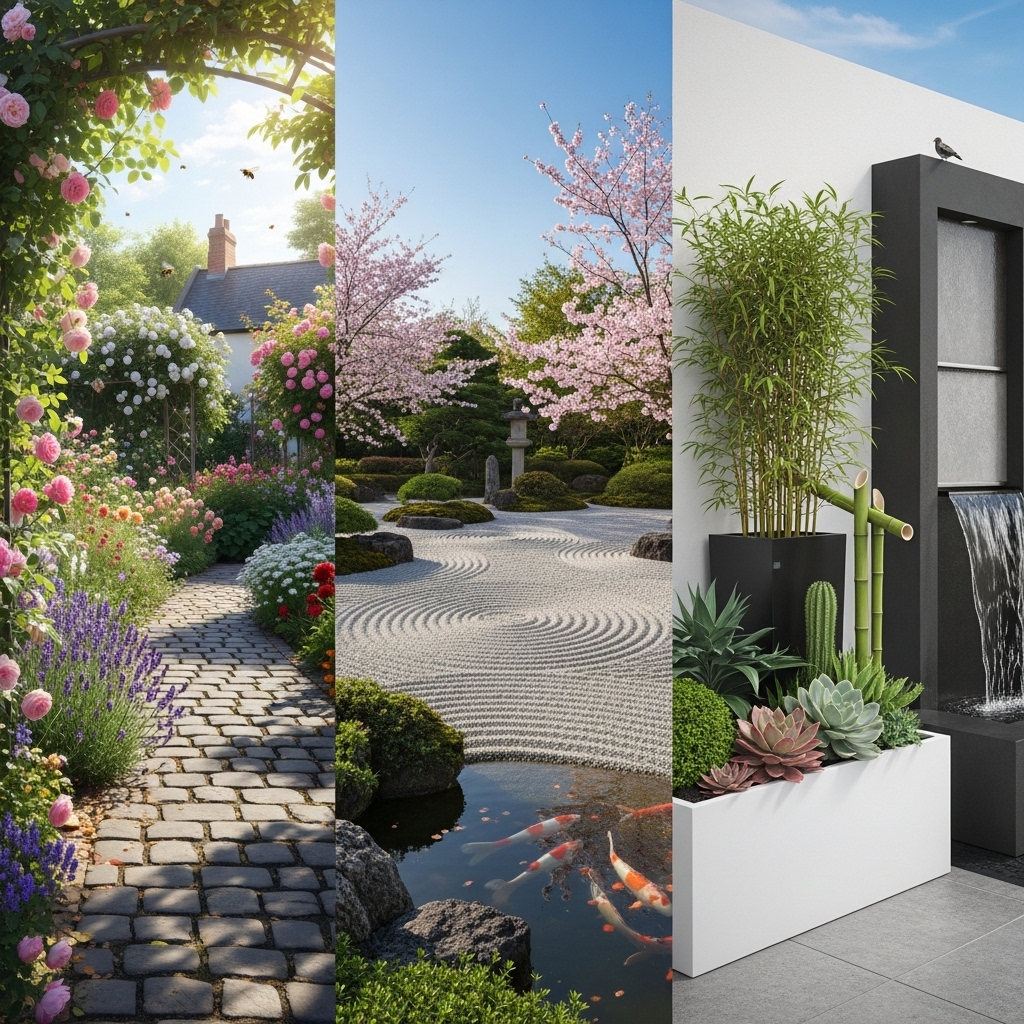Discovering your perfect garden style can transform your outdoor space into a personal haven. From the romantic allure of an English cottage garden to the sleek lines of modern minimalism, the possibilities are endless, allowing you to express your creativity and personality.
Exploring Garden Styles

As I began my journey into the world of gardening, I quickly realized that the style of my garden could significantly influence not only its aesthetic but also my overall enjoyment of the space. Each garden style tells a story, reflecting personal tastes, environmental conditions, and the relationship we have with nature. Whether I wanted a vibrant, flower-filled landscape or a serene, minimalist retreat, understanding various styles helped me make informed choices. Here, I’ll delve into some popular garden styles, starting with the enchanting English cottage garden.
English Cottage Garden
The English cottage garden has always captivated me with its charming, organic aesthetic. This style is characterized by a delightful mix of colorful flowers, herbs, and vegetables, all planted in a seemingly haphazard manner. I adore how this style encourages a sense of abundance, where each plant complements the other while creating a lush tapestry of blooms.
When I embraced the English cottage style, I found that the key elements include:
- Diverse Planting: You’ll often find a variety of perennials, annuals, and self-seeding plants. I personally love incorporating roses, foxgloves, lavender, and daisies. They all thrive together, creating an inviting atmosphere.
- Curved Pathways: I discovered that winding pathways made from natural stones or gravel lead visitors through the garden, adding an element of surprise and discovery. It’s a wonderful way to invite exploration.
- Rustic Features: I added elements like wooden trellises, arbors, and even a quaint birdbath, which contribute to the overall charm. These features not only enhance the beauty but also provide habitats for wildlife.
The beauty of an English cottage garden lies in its informality. There’s no need for strict symmetry or rigid organization. Instead, I reveled in the joy of letting my plants grow freely, embracing the natural chaos that defines this style.
Modern Minimalist Garden
On the other end of the spectrum lies the modern minimalist garden, which speaks to my love for clean lines and simplicity. This style embraces the less-is-more philosophy, focusing on a few key elements that create a striking impact. I appreciate how a minimalist garden can evoke tranquility and clarity in an otherwise cluttered world.
Key characteristics of a modern minimalist garden include:
- Simplicity in Planting: I learned that choosing a limited selection of plants with bold architectural shapes can make a profound statement. Think of ornamental grasses, succulents, or striking shrubs – each plant stands out on its own.
- Geometric Layout: Clean lines and structured layouts are essential in this style. I often use rectangular garden beds and straight pathways that guide the eye through the space.
- Neutral Color Palette: The focus is on muted tones and monochromatic schemes. I enjoy incorporating whites, greens, and grays, which create a calm and soothing atmosphere.
With my minimalist garden, I found that every element serves a purpose. The lack of clutter allows me to immerse myself in the beauty of the space without distractions. Each time I step into my garden, I feel a sense of peace and mindfulness, a reprieve from the chaos of everyday life.
Choosing the Right Style for You
As I experimented with these diverse garden styles, I discovered that finding the right one for me was a journey worth taking. I realized I could blend elements from different styles to create a unique garden that reflects my personality and fulfills my needs. Understanding the characteristics of each style helped me make thoughtful choices based on my preferences, space, and the amount of time I could dedicate to maintenance.
When deciding on your own garden style, consider the following:
- Your Lifestyle: A busy schedule may lean you toward a low-maintenance minimalist garden, while those with more time might relish the hands-on approach of a cottage garden.
- Environmental Conditions: Evaluate your space for light, soil type, and climate. Certain styles may naturally align with the growing conditions in your area.
- Personal Aesthetic: Reflect on the styles that resonate with you. Do you prefer the soft romanticism of a cottage garden, or does the clean, modern feel speak to your soul?
Ultimately, gardening is about creating a sanctuary. Each style offers a different vibe and experience, and I encourage you to explore them all. Your garden should be a place of joy, creativity, and healing, and finding the right style can make all the difference.
Gardening Styles from Around the World

As I ventured deeper into the realm of gardening, I found myself fascinated by styles from different cultures and regions. Each gardening style tells a unique story rooted in history, climate, and the relationship between people and nature. Exploring these diverse styles has not only enriched my gardening experience but also expanded my appreciation for the art of gardening itself. Let me share some of the captivating styles I encountered along the way.
Japanese Zen Garden
The Japanese Zen garden, or karesansui, truly resonates with my love for tranquility and mindfulness. These gardens are designed to inspire reflection and meditation, often incorporating elements like rocks, gravel, and minimal plant life. The simplicity and serene atmosphere of a Zen garden offer me a peaceful escape from the busyness of daily life.
Key elements that define a Japanese Zen garden include:
- Raked Gravel or Sand: I learned that the raked patterns in gravel symbolize water waves, creating a calming visual effect. This aspect allows me to engage in a meditative practice, as I rake the gravel into intricate designs and appreciate the process itself.
- Strategic Placement of Rocks: The placement of rocks holds significant meaning in Zen gardens, often representing mountains or islands. I enjoy selecting carefully shaped stones that evoke a sense of balance and harmony within the space.
- Minimalist Planting: While plant life is kept to a minimum, I find that including a few carefully chosen elements like moss, bamboo, or small shrubs can enhance the garden’s natural beauty without overwhelming it.
In my own Zen garden, I realized that the focus is less on vibrant colors and more on textures and contrasts. This minimalist approach encourages me to connect with nature on a deeper level, fostering a sense of peace and clarity.
Italian Renaissance Garden
On the flip side, the grandeur of the Italian Renaissance garden speaks to my admiration for structured beauty and historical elegance. These gardens are characterized by geometric designs, symmetry, and a strong emphasis on architecture. I am continually inspired by the meticulous planning and artistry that goes into creating a space that is both functional and visually stunning.
Key features of an Italian Renaissance garden include:
- Formal Layout: The garden is often divided into distinct sections, with straight paths leading to focal points such as fountains, statues, or beautifully trimmed hedges. This organized layout makes every corner of the garden feel intentional and purposeful.
- Water Features: I’ve always been captivated by the soothing sound of water. Fountains and reflecting pools not only add a sense of luxury but also create microclimates that can support a variety of plant life.
- Terraced Areas: Many Italian gardens employ terraces to create elevation changes, providing stunning views and adding depth to the landscape. Incorporating raised beds or tiered plantings can create a similar effect in my own space.
When I walk through an Italian Renaissance garden, I am transported to a world of elegance and sophistication. The careful attention to detail and artistic design reminds me that gardening can be both a practical and expressive art form.
Permaculture Garden
As I delved into sustainable gardening practices, I discovered the permaculture style, which emphasizes working with nature rather than against it. This holistic approach to gardening has profoundly influenced how I view my garden and its ecosystem. I appreciate the focus on biodiversity and sustainability, which aligns perfectly with my values.
Key principles of a permaculture garden include:
- Companion Planting: I have learned that planting certain crops together can enhance growth and repel pests. For example, pairing tomatoes with basil not only boosts flavor but also supports healthier plants.
- Soil Health: The health of the soil is paramount in permaculture. I have embraced practices like composting and mulching to enrich the soil naturally and support a thriving ecosystem.
- Water Management: Techniques such as rainwater harvesting and creating swales help conserve water and manage runoff. I’ve found that even small changes can make a significant impact on water usage in my garden.
Embracing permaculture has transformed my gardening practice into a more mindful and responsible endeavor. It’s not just about growing food; it’s about fostering a harmonious relationship with nature and supporting the environment.
Finding Inspiration in Global Styles
As I explore these diverse gardening styles, I find inspiration in the way each reflects cultural values and environmental needs. Whether it’s the tranquility of a Zen garden, the elegance of an Italian Renaissance garden, or the sustainability of a permaculture garden, each style offers unique insights and inspiration for my own outdoor space. The beauty of gardening is that I can draw from these influences to create a garden that resonates with me personally.
Ultimately, my garden journey is about exploration and self-discovery. Each style I embrace not only informs my gardening choices but also deepens my connection to the natural world. As I continue to experiment and blend these influences, I look forward to cultivating a garden that is not just a reflection of my tastes, but also a tribute to the diverse traditions that inspire me.
Final Thoughts
Gardening is a beautiful adventure that allows us to explore creativity, culture, and sustainability. By embracing various styles and practices from around the world, I’ve found not only a passion for gardening but also a deeper appreciation for the environment. As I tend to my garden, I am reminded that each style offers a unique lens through which to view the world and connect with nature. I encourage you to embark on your journey, explore different styles, and create a garden that speaks to your heart and soul. Your garden can become a sanctuary where art, nature, and personal expression come together in harmony.
